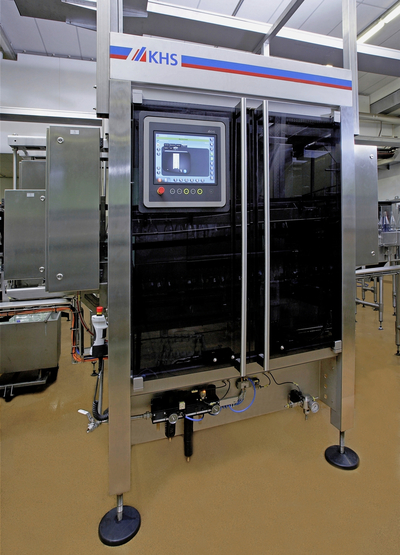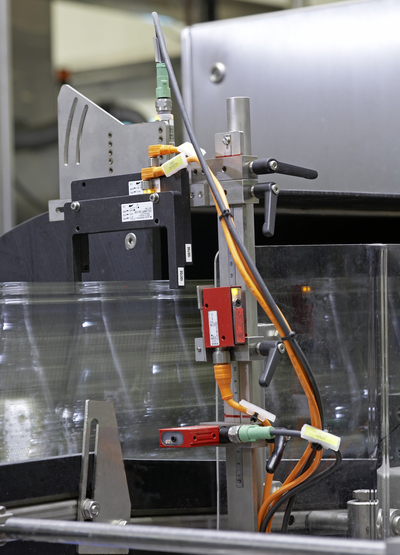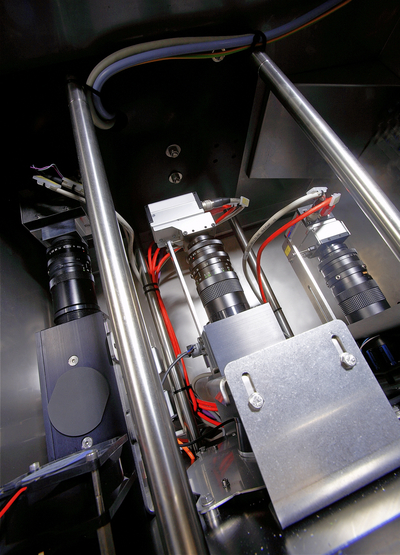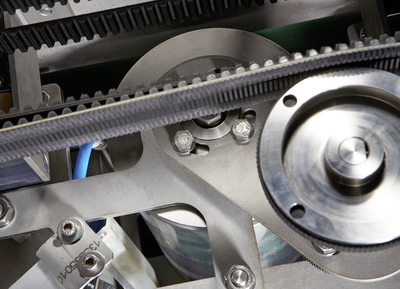
The Multitasking, Multitalented Machine
Neues KHS-Leerflascheninspektions-System Innocheck EBI setzt Zeichen
Jürgen Herrmann*
Perfect bottle quality and best product quality are mutually conditional. In order to achieve excellent filling results in beverage production, this must be a given. So that the best possible bottle quality is ensured, empty bottle inspection with maximum inspection reliability has become indispensable, especially in refillable container systems. With its newly developed Innocheck EBI empty bottle inspection system, KHS provides just this. The setup detects damaged and dirty bottles and those with visible flaws just as reliably as bottles containing residual liquids or foreign substances and those with damaged mouths. And yet these are not all of the benefits of the new system. The Innocheck EBI also creates a data profile of each and every bottle that can be retrieved whenever needed – a feature as yet unparalleled. The new KHS inspection system is also distinguished by its simple and hygienic design, compact construction, flexibility and future viability, and high availability. Taking all this into account, one could venture to say that with the Innocheck EBI a new age of empty bottle inspection technology has dawned for the beverage industry – one that will point the way forward on an international scale.
Linear empty bottle inspector for fast changeovers
The Innocheck EBI is a linear empty bottle inspector. In comparison to the rotary-type machine, the compelling feature of the linear inspector is that less time and effort is involved in bottle changeover. All that needs to be done when switching the bottle format is to simply adjust the drive belt, making changeover extremely fast so that production can restart within a very short space of time.
Inspection of 60,000 glass bottles an hour
The Innocheck EBI has a nominal inspection capacity of up to 60,000 glass bottles an hour. Standard inspection is of various bottle styles ranging from 0.2 to 1.5 liters in size. If bottles that are larger or smaller than this are to be inspected, the Innocheck EBI can be constructed to suit individual requirements.
* Manager, Inspection Technology Competence Center, KHS GmbH, Dortmund.
Phone: +49 (231) 569-10117
Preliminary inspection included
As a matter of principle the Innocheck EBI includes a preliminary inspection of all bottles. In this procedure bottles are checked to see if they meet requirements or if they are too tall, too short, too wide, too narrow, or have flawed mouths. Preliminary inspection makes use of sensory equipment, with ultrasound sensors looking down onto the mouth of each individual bottle and calling up data on the type of bottle mouth and bottle height. Infrared detectors measure the width and height of the bottles. If the bottles are not within preset tolerances or if defects at the bottle mouth are detected, a pusher rejects these bottles into a glass receptacle provided for this purpose. This enables disruptions and stops on the base machine to be avoided right from the outset.
Individual ID number for each and every bottle
At the inspection machine infeed each individual bottle is logged by an infrared sensor and assigned its own ID number, a number that is then specifically scanned by all detection units within the system. This enables each and every bottle to be precision tracked within the setup, providing the utmost inspection safety.
One example that illustrates just how reliable this use of ID numbers can be is described by the following scenario. Should the line suddenly stop, bottles could accumulate in a mass formation, causing their positions to shift. If this happens within the Innocheck EBI area and if one bottle can no longer be clearly identified by the ID check, as with all other conceivable inconsistencies this bottle is automatically rejected once it has run through the machine. This allocation of ID numbers offers the highest standard of safety a linear machine can have. This ID system, implemented for the first time in the beverage industry for empty bottle inspection, is based on technical systems used in the field of high security.
Complex inspection data retrievable at all times
If a bottle is recognized by its ID number before reaching the reject station in the Innocheck EBI and marked as a 'good' bottle by comparing the collated data with specified target values, it is conveyed on towards the filling system. This bottle also provides information on the results of all inspections stages it has passed through – another clear advantage that also applies to 'bad' bottles. These results can later be easily accessed at any time. This means that if required, inspection data can be used to compile overall statistics or specific statistics on select bottle inspection criteria, and that any number of queries and evaluations can be made whenever required.
Outer sidewall inspection times four
The first stage of inspection in the Innocheck EBI is to check the outer sidewalls. The empty bottle inspector has a total of four sidewall inspections, with two at the infeed and two more at the discharge end of the machine. An LED flash unit on the one side of the bottle in each sidewall inspection acts as a light source, with a high-resolution camera installed on the other side. Special reflective hollow shaft mirror optics used for the camera images has the advantage that a wider view of the bottle is provided as opposed to classic systems. The camera and LED flash unit are each arranged in mirror image at both the first and second sidewall inspection at the infeed and at the third and fourth sidewall inspection at the discharge. The bottles are specifically rotated while being conveyed through the Innocheck EBI, meaning that at the end of all sidewall inspections they have been subjected to a 360-degree inspection, thereby ensuring 100% inspection safety.
Plastic belts for gentle conveying
As soon as the bottles have passed through their first and second sidewall inspection, they are transported through the Innocheck EBI on parallel belts. These plastic belts not only gently convey the bottles through the base machine; they are also synonymous with easy maintenance and hygienic design.
Consistent implementation of hygienic design
Great importance was attached to the consistent implementation of hygienic design in the development of the Innocheck EBI. The machine construction with its smooth surfaces and laterally open pipes permits easy, reliable, and speedy cleaning. The gabled roof structure enables any condensation that may form to easily run off, particularly in warmer climates. The Innocheck EBI is also completely open towards its base. Foreign substances and liquids thus drip straight onto the floor and can be quickly removed.
Bottle mouth inspection
The next step in the Innocheck EBI inspection system is to check the bottle mouth. The light directional characteristics of an LED light flash have been configured so that the sealing surface of the bottle mouth is perfectly illuminated. The mouth is reflected upwards by a parallel optical system in the direction of the camera which then photographs only the upper circular mouth area. The outer ring, inner ring, and sealing surface are then inspected. The view of the bottle mouth can also be extended by introducing an optional bottle mouth lip inspection – an additional measure that is particularly suitable for beer bottles.
Bottle base, inner sidewall, and infrared residual liquids inspections integrated in just one optical block
Another considerable improvement and a major plus of KHS' new empty bottle inspector is the fact that bottle base, inner sidewall, and infrared residual liquids inspection now all take place together within one optical block specially designed for this purpose. The unit is equipped with various mirrors and what are known as splitters that have various different levels of light wave transparency. The optical unit is operated from a single light source for all three checks, with the advantage that there are no disruptions in the inspection process caused by different flashes of light generated within the system for each individual inspection.
Encapsulated, automatically cleaned light source for maximum line availability
The fact that the sole light source for the optical block is encapsulated in a transparent roll is likewise advantageous – and KHS has it registered as patent pending. This transparent roll runs synchronously with the chain drive. It is automatically cleaned by a jet of water and a wiper integrated in the system that works like a windshield wiper. Thanks to encapsulation and automatic cleaning the light source is ready for use at all times. Manual cleaning is no longer necessary, specifically saving on time. In empty bottle inspection setups employed to date it was usual for light sources to be manually cleaned once to ten times an hour. An average of three minutes had to be put aside for each cleaning operation carried out by hand, during which the inspection machine and thus the entire line were down. Even if the light sources were only cleaned once an hour, this meant a 5% loss in production time. At an assumed 5,000 hours of production a year the total loss of production time – with just one clean an hour – was 250 hours. With the launch of the Innocheck EBI, no more production time is lost due to cleaning – which not only results in a higher availability of both the machine and the line but also in considerably lower costs.
Bottle base inspection makes use of various algorithms
During bottle base inspection the bottle base and bottle standing surface are scanned using a number of different algorithms. The system first concentrates on the inner base area and thus on detecting particles of dirt, possible cracks in the glass, and other defects. During the bottle base check, light-to-dark transitions are specifically filtered out and individually examined using a special inspection algorithm – in itself an example of maximum precision inspection. The camera used for bottle base inspection views the bottles lit from below by an LED flash through an optical tower. The same procedure is applied to inner sidewall inspection that follows the bottle base check, for which a separate camera system focused on the inner sidewall records images.
Redundant camera systems are an option
Regarding high availability alone, another huge benefit of KHS' new empty bottle inspection machine is that both of these inspections – like all the other optical systems in the Innocheck EBI – can be equipped with additional redundant camera systems. If one camera fails when the camera redundancy option has been selected, a second is automatically switched into the inspection process.
Infrared residual liquids inspection for non-conductive liquids
In infrared residual liquids inspection the high-power infrared light sources integrated in the LED flash unit of the optical tower come into play. Here, too, light is projected from the base up into the optical tower. The more liquid absorbing infrared light contained in a bottle, the less light arrives at the evaluation sensor from the filtered wavelength range. Infrared residual liquids inspection detects non-conductive fluids such as oil and gasoline, for example.
High-frequency residual liquids inspection detects conductive liquids
The final inspection prior to the last two outer sidewall checks centers on high-frequency residual liquids. Maximum safety is also the motto here. While infrared residual liquids inspection recognizes non-conductive fluids, high-frequency residual liquids inspection detects conductive fluids, covering the entire spectrum of possible liquids to perfection.
Extremely compact machine design
The fact that three inspection processes are integrated in just one unit is a major advantage of the Innocheck EBI that has resulted, among other things, in its extremely compact design. The total length of the Innocheck empty bottle inspector, including the outer sidewall inspection units, is just 2.60 meters or 8½ feet. The Innocheck EBI thus takes up a minimum of space when integrated in existing filling lines.
Thread inspection
After inspection inside the optical tower has been completed, thread inspection is on the agenda. In this process each thread is illuminated in a specified angle of emission. Light is projected externally through the thread towards the inside of the bottle, with the image of the thread being projected upwards through a hypercentric lens into the angle of incidence of the camera's optical range. The camera image is similar to a slice of onion; if there is a defect in the thread, this is depicted as a gap in the 'onion ring'.
ID inspection and recall of all collated data
With the high-frequency residual liquids check over, the bottles run onto chain conveyors which transport them through the two aforementioned sidewall inspections at the discharge. The ID allocated to each bottle at the infeed is checked at the discharge itself. All data collected during each stage of inspection is specifically called up – if the ID number is correct – and check algorithms applied to it, the results of which determine whether the bottle is to be classified as 'good' or 'bad'. All recalled data is recorded in the system and can be called up at any time.
Maximum flexibility – also with regard to additional inspection components
The system is also extremely flexible when it comes to integrating other inspection technologies at a later stage. Once they have been installed in a line, all inspection units imaginable in a line or machine setup – such as bottle color detection or fill level and closure inspection – can be easily docked onto the Innocheck CUB control unit integrated in the Innocheck EBI. The necessary software is installed on the Innocheck CUB control unit and once activated can be adapted to suit required individual standards. The system is also particularly operator-friendly, with the plausibility of each inspection process chain created by the user, generated from an existing KHS library toolbox, and simultaneously documented, being specifically verified. What's more, the statistics, error messaging, diagnosis, and parameterization menu bars are in five languages and can even be changed to a different linguistic version during operation. In addition, the Innocheck CUB unit consists of standard industrial components that can be procured worldwide, once again increasing availability.
The hardware platform can also be quickly adapted to new situations and conditions. If a computer module in the control unit reaches its limits of performance, all that is needed is to open the CUB terminal and insert another module. It just couldn't be simpler – or better geared for future eventualities.
Automatic test bottle program
Prepared test bottles are used at set intervals to test the empty bottle inspector and ensure that it is in proper working order. The test bottle program triggers itself with the message "Start test bottle program" in full accordance with the given cycles. The operator activates the automatic test bottle program by simply pressing a button on the operator terminal. The Innocheck EBI ascertains at the discharge whether all flaw characteristics have been reliably detected by the various devices.
In its standard version the Innocheck EBI comes with two rejection systems. One of them organizes the return of dirty bottles to the bottle washer, the other rejects damaged or contaminated bottles, disposing of them in a bottle waste receptacle.
Bottom line: Innocheck EBI has plenty of advantages
The Innocheck EBI is an empty bottle inspection system that is definitely pointing the way forward – in many respects. As a compact unit, the system is not only extremely precise in its inspection procedures but also boasts a level of availability and range of data that are second to none. It also offers maximum flexibility when it comes to the hardware and software and is especially easy to operate. The Innocheck EBI truly is a multitasking, multitalented inspection system that can provide the beverage industry with an entire range of significant advantages. And not only that; in the near future these benefits will also be applicable to empty PET bottle inspection ...




